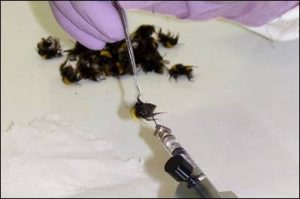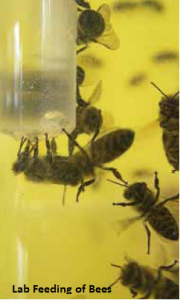As a general rule, insecticides are more toxic to honey bees than fungicides and herbicides, but most insecticides can be applied to crops with little or no hazard to bees. However, because honey bees are insects, they are highly sensitive to several types of insecticides and it is important to follow all label precautions.
Most poisonings occur when BEE-TOXIC INSECTICIDES (explained below) are APPLIED to crops during the BLOOMING PERIOD. Poisoning of pollinators can ALSO result from:
- DRIFT of pesticides onto adjoining crops or plants that are in bloom,
- CONTAMINATION OF FLOWERING GROUND COVER plants when sprayed with pesticides,
- Pesticide RESIDUES, PARTICLES, OR DUSTS being picked up by foraging pollinators and taken back to the colony, and/or,
- Pollinators drinking or touching CONTAMINATED WATER sources or dew on recently treated plants.
The U.S. Environmental Protection Agency (EPA) evaluates a pesticide for toxicity to pollinators if it is used outdoors. A pesticide’s toxicity to bees is measured by:
- The pesticide dose that causes death of bees; and
- How long the pesticide can affect bees after it has been applied to plants.
Studies required by EPA to assess a pesticide’s toxicity

Contact Toxicity Treatment (SynTechResearch.com)
The initial, and still integral, toxicity test is the adult honey bee acute contact study. This lab study determines the amount of pesticide that kills 50% of a test group of bees, or LD50. (LD=Lethal Dose).
- If the Acute Contact LD50 is less than or equal to 2 micrograms per bee, the pesticide is classified as Toxicity Group I, “highly toxic to bees.”
- If the LD50 is less than 11 but greater than 2 micrograms per bee, it is classified as Toxicity Group II, “toxic to bees.”
- If the LD50 of the pesticide is greater than 11 micrograms per bee (Toxicity Group III), it is relatively nontoxic, and no bee caution statement is required on the label.
Toxicity Groups I and II are “bee-toxic pesticides” and the label will have specific use instructions to reduce the risk to pollinators (see Read and Follow the Label). A bee-toxic pesticide that does not have extended residual toxicity (next paragraph) can often be applied after pollinator foraging is complete (such as in the early evening) without harming pollinators that arrive the following day.
The toxicity of residues on foliage study determines the amount of time that pesticide residues on leaves (foliage) remain toxic to honey bees. The pesticide is applied to crop foliage–the foliage is harvested at predetermined post-application intervals–and test adult bees are confined on foliage with aged residues for 24 hours. Three treatment intervals (different durations of time that residues are aged between application and harvest) are typically used (e.g., 3, 8, and 24 hours post-application). If the mortality of bees exposed to the foliage harvested 24 hours after the application is greater than 25%, bees should continue to be exposed to aged residues on foliage samples collected every 24 hours (i.e., 48, 72, 96 hours, etc. after the application) until mortality is 25% or less. From these data, the number of hours (post-treatment) that the residue remains toxic to 25% of the bee population (RT25) is determined. It is believed that 25% of the colony can be lost and the colony can regenerate. Therefore, bee-toxic pesticides with RT25 values lower than 8 hours present a minimal hazard if they are applied during late evening or night–the residue degrades over time to less toxic compounds before bees visit the treated area/crop in the morning. Pesticides with RT25 values greater than 8 hours have Extended Residual Toxicity (ERT) that require somewhat different or additional protective measures.
EPA has compiled data of RT25 values for various active ingredients. It is not available for all pesticides. (Systemic pesticides are not considered in RT25 assessments; it is based solely on surface contact and exposure.)
The 3-Tiered Risk Assessment Process
EPA’s current risk assessment guidance provides a more comprehensive framework for evaluating pesticide risk to bees and is based on many more studies compared with the two tests described above. Additional studies evaluate different life stages (adults and larvae/brood), exposure durations (acute and chronic), and routes of exposure (contact and ingestion/oral). Data required under this framework arise from three tiers of studies:
- Tier 1 consists of laboratory toxicity studies with both adult and larval honey bees exposed for acute and chronic durations.
- Tier 2 ‘effects’ studies include feeding and tunnel studies in which honey bee hives are exposed to pesticides in a more realistic setting than the laboratory. Tier 2 ‘residue’ studies measure exposure based on pollen and nectar residue data from pesticides applied to crops using different application methods.
- Tier 3 studies are generally large-scale field studies that most closely resemble an in-field exposure scenario for honey bees.
The EPA considers this new policy another step forward in protecting bees from possible adverse effects of pesticides. For more details, read the document entitled Process for Requiring Exposure and Effects Testing for Assessing Risks to Bees during Registration and Registration Review.
The Pesticide Toxicity to Bees “Traffic Light” is a helpful guide that categorizes various pesticide products by their relative toxicity to honey bees.
John W. Allran reviewed and contributed to this page. He was the Environmental Toxicologist with the NC Dept. of Ag. & Consumer Services, Structural Pest Control & Pesticides Division and now works with the U.S. Environmental Protection Agency.